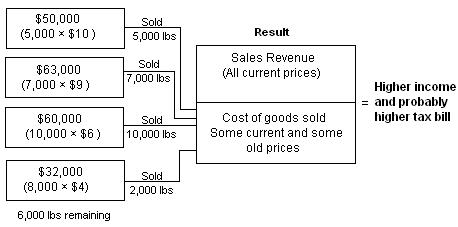LIFO Liquidation:
(An Issue Related to LIFO
Inventory Valuation Method):
Learning objectives of this article:
-
Define and explain the term "LIFO Liquidation".
Definition of LIFO Liquidation:
The
erosion of the LIFO inventory is referred to as
LIFO liquidation. Erosion means the
unavailability or shortage of raw materials or other
inputs that enforces companies to use its existing
assets. LIFO liquidation leads to distortion of net
income and substantial tax payments.
Example:
To
understand the LIFO liquidation problem assume that
XYZ company has 30,000 ponds of steel in its
inventory on December 31, 2004. Costed on a
traditional LIFO approach.
|
Ending Inventory 2004 |
|
|
Ponds |
Unit
Cost |
LIFO Cost |
|
2001 |
8,000 |
$4 |
$32,000 |
|
2002 |
10,000 |
6 |
60,000 |
|
2003 |
7,000 |
9 |
63,000 |
|
2004 |
5,000 |
10 |
50,000 |
|
|
|
|
|
|
|
30,000 |
|
$205,000 |
|
|
|
|
|
|
The
ending 2004 inventory comprises costs from past
periods. These costs are called layers (increase
from period to period). The first layer is
identified as the base layer. The layers for XYZ are
shown below:
2004
Layer |
$50,000
(5,000 × 10) |
2003
Layer |
$63,000
(7,000 × 9) |
2002
Layer |
$60,000
(10,000 × 6) |
2001
Base Layer |
$32,000
(8,000 × 4) |
|
The
price of steel has increased over the 4 year period.
In 2005, the company experienced a metal shortages
and had to liquidate much of its inventory (a LIFO
liquidation). At the end of 2005, only 6,000 ponds
of steel remained in inventory. Because the company
is using LIFO, the most recent layer, 2004, is
liquidated first, followed by the 2003 layer and so
on.
As a
result the costs from preceding periods are matched
against sales revenues reported in current dollars.
This leads to a distortion in net income and a
substantial tax bill in the current period. These
effects are shown below:

To
alleviate the LIFO liquidation problems and to
simplify the accounting, goods can be combined into
pools. A pool is defined as a group of items of a
similar nature. Thus, instead of only identical
units, a number of similar units or products are
combined and accounted for together. This method is
referred to as the specific goods pooled LIFO
approach. With the specific goods pooled LIFO
approach, LIFO liquidations are less likely to
happen because the reduction of one quantity in the
pool may be offset by an increase in another.
The
specific goods pooled LIFO approach eliminates some
of the disadvantages of the specific goods
(traditional) accounting for LIFO inventories. This
pooled approach, using quantities as its measurement
basis, however, creates other problems.
First
most companies are continually changing the mix of
their products, materials, and production methods. A
business once engaged in manufacturing train
locomotives may now be involved in the automobiler
or aircraft business. A business that had used
cotton fabric in its clothing now uses synthetic
fabric (dacron, nylon, etc.). If a pooled approach
using quantities is employed, such changes mean that
the pools must be continually redefined. This can be
time consuming and costly.
Second, even when such
an approach is practical, an erosion (LIFO
liquidation) of the layers often results, and much
of the LIFO costing benefit is lost. An erosion of
the layers results because specific good or material
in the pool may be replaced by another good or
material either temporarily or permanently. This
replacement may occur for competitive reasons or
simply because a shortage of a certain material
exists. Whatever the reason, the new item may not be
similar enough to be treated as part of the old
pool. Therefore any inflationary profit deferred on
the old goods may have to be recognized as the old
goods are replaced.
Relevant Articles:
|